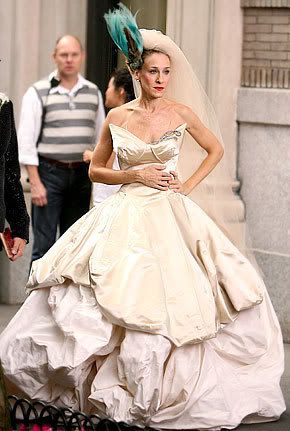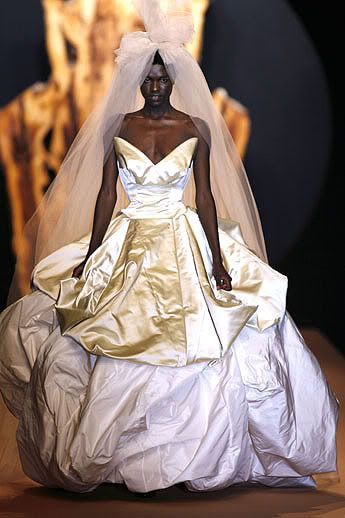This article was rejected from HF's day job for being too "ranty." Point taken. But when a fashion-centric entity prominently features a dress that we pulled from the Vivienne Westwood Fall 07 collection months ago for this blog--and when a cherished favorite sells its soul to the highest bidder--we're entitled to a bit of ire.

“Women come to New York for the two L's: Labels and Love,” announces Carrie Bradshaw at the beginning of Sex and the City: The Movie. But unlike the original TV series, it is the latter “L” that dominates this time around—the film serves as a two-hour commercial for the most prominent labels in fashion. At every turn the audience is reminded not of the quirks, trials and redemptions of love and life in New York City, but of who supplied the girls’ clothes and accessories. In one scene Carrie actually runs down a laundry list of designers (including Carolina Herrera, Christian Dior and Vivienne Westwood) as she models wedding dresses.
There is plenty of reason to be excited about all the fabulous accessories stealing the show, even when the clothes may borderline on ridiculous… Gorgeous high heels (notably opened-up shoe booties, fishbone Guiseppe Zanotti stilettos and a stunning electric blue satin Manolo pump), “It” bags galore (from Prada clutches to frayed tweed Chanel), playful hats and some spectacular unnamed jewels.
Unfortunately, as fabulous as the fashions are, much is sacrificed in order to accommodate the high-priced designer name drops. Jennifer Hudson’s character Louise is reduced at times to a mere vehicle for more label dropping (this portion made possible by Louis Vuitton). The sheer beauty and emotional impact of such dazzling accessories is too often interrupted by a spoken credit or a close-up of the packaging. And Patricia Fields’ innovative and eclectic costuming feels more designer-driven and age inappropriate than ever—many pieces are lifted straight from the runway, making them more recognizable to consumers. While retailers certainly benefit from all the label lust, the characters’ distinct personal style—one of the things that made the show so noteworthy—takes a definite hit. Even vintage pieces unearthed by Field (like Carrie’s wide studded belt, worn repeatedly) are so similar to current designer looks that it becomes difficult to distinguish them.
Indeed, for high-end retailers the power and prominence that big-name brands hold in the movie is a blessing, as it sends the message that paying attention to—and paying extra for—designer labels is a necessary part of being fashionable. This message is sure to resonate with SATC’s more recently acquired young adult fan base, which, thanks in part to edited syndication, worship the SATC girls as style icons. Whatever labels Carrie carries, teen girls inevitably want. In retrospect, the new younger audience even shines an ironic light on Season 3’s ‘Hot Child in the City’ episode, in which the girls encounter a trio of wealthy thirteen-year-old girls who dress and talk “just like us.” But the downside of that influence is that fashion-forward junior customers—treasured purveyors of self-expression and DIY style—may come away with a new mentality towards label-hungry copycat dressing.
It is true that designer names and fashions have always been spotlighted in the original series, and the latest New York hotspots promoted by name. But each episode was generally limited to one well-selected name, incorporated as an integral plot element that served a greater purpose: Dolce & Gabbana dress Carrie in a runway show that combines her ultimate fantasy with ultimate embarrassment; when Carrie takes Season 6 boyfriend Berger to shop at Prada, the experience reveals his inability to handle her successful career. Likewise the pinnacle names themselves were almost always spoken with wit, clever puns, and impeccable comic timing. (“I lost my Choo!” “Give me your purse… and your Manolo Blahniks!”) In that respect, at least the movie’s Cinderella-inspired Manolo proposal got it right.
Did the shorter half-hour spans and week’s wait in between provide a less dense, less obvious venue for so many labels? Definitely. But even then, at the end of the day the most important thing was still having your friends. At the movie’s end, the Fergie track “Labels or Love” spells out the new priority: “Shopping for labels, shopping for love / Manolo and Louis, it’s all I’m thinking of…”
Our girls used to think about a lot more.

Vivienne Westwood A/W 07
(In the spirit of name-dropping, HF must credit her soon-to-be former assistant Vanessa for writing part of this... the less ranty part.)
No comments:
Post a Comment